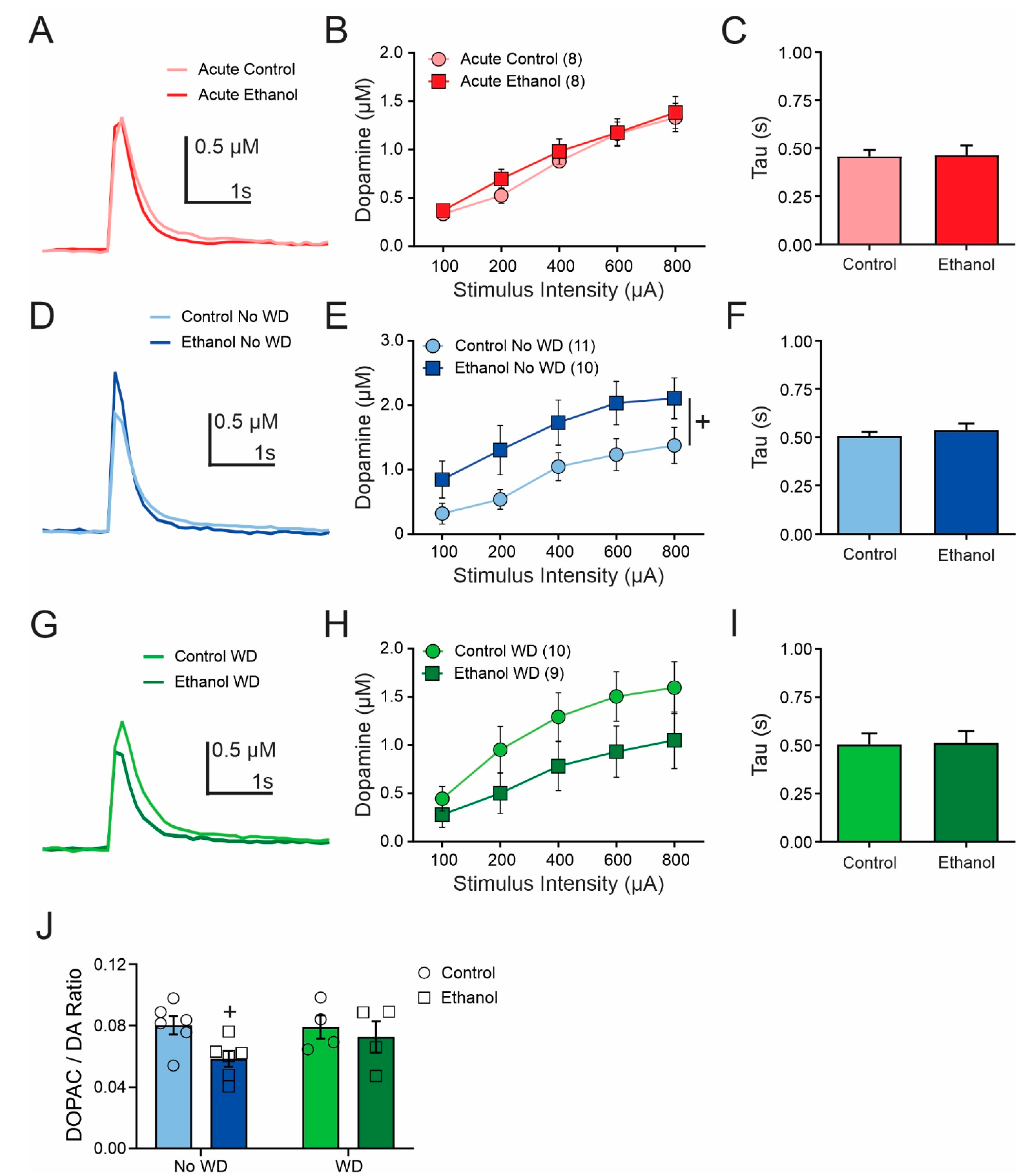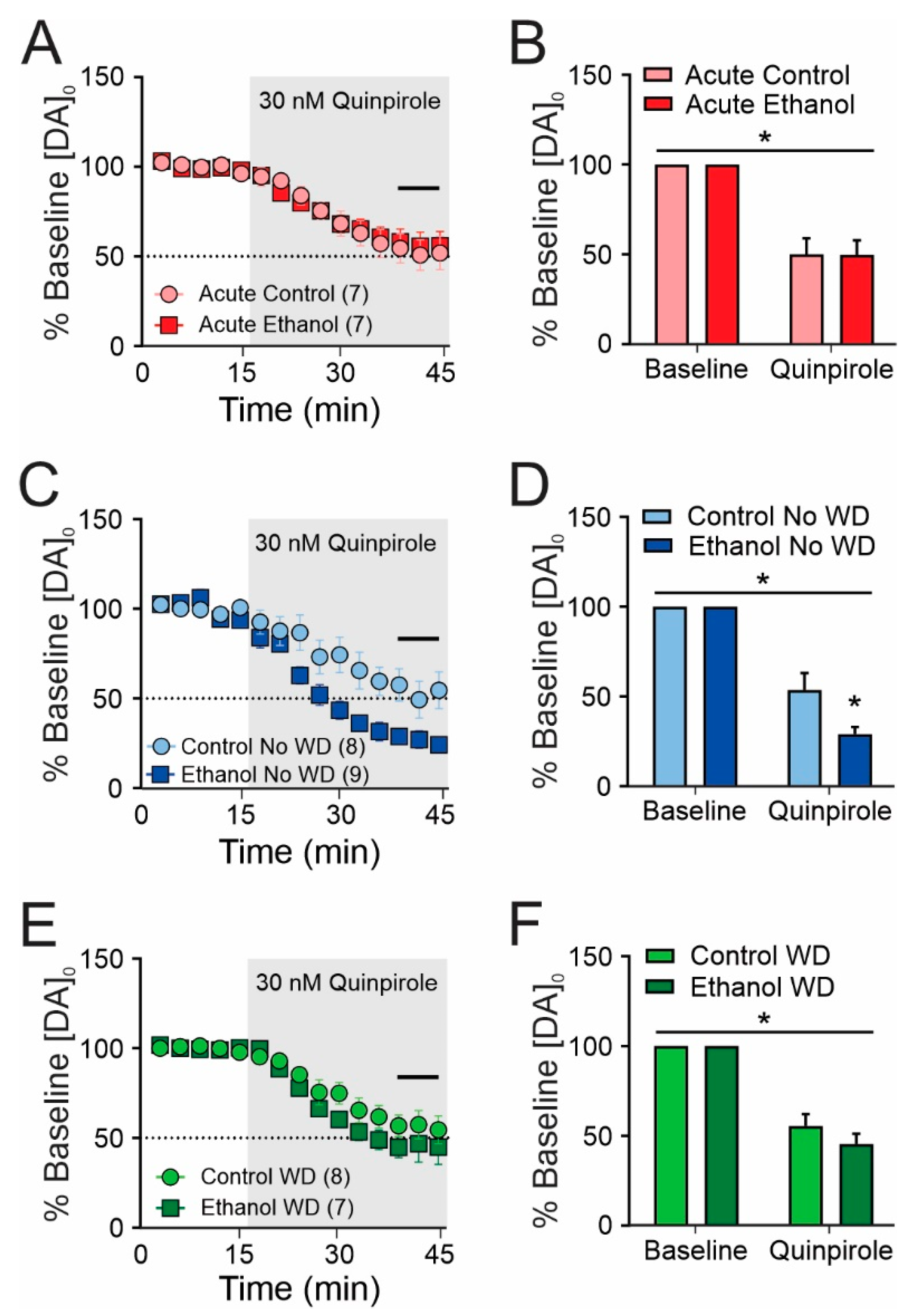Chronic Ethanol Consumption Alters Presynaptic Regulation of Dorsal Striatal Dopamine Release in C57BL/6J Mice
Abstract
1. Introduction
2. Results
2.1. Two-Bottle Choice Ethanol Consumption
2.2. Dopamine Release and Tissue Content Were Not Significantly Altered by Acute or Chronic Ethanol Consumption
2.3. Chronic Ethanol Consumption Increases D2 Dopamine Autoreceptor Sensitivity
2.4. Chronic Ethanol Consumption Decreases nAChR Contribution to Dopamine Release
3. Discussion
3.1. Summary of Findings
3.2. Ethanol Drinking and Dopamine Release
3.3. Altered Presynaptic Regulation of Dopamine Release
4. Materials and Methods
4.1. Subjects
4.2. Experimental Design
4.3. Two-Bottle Choice Ethanol Consumption
4.4. Blood Ethanol Concentration
4.5. Tissue Dopamine Content
4.6. Brain slice Preparation
4.7. Fast-Scan Cyclic Voltammetry
4.8. Drugs and Reagents
4.9. Statistics
Author Contributions
Funding
Institutional Review Board Statement
Data Availability Statement
Conflicts of Interest
References
- American Psychiatric Association. Diagnostic and Statistical Manual of Mental Disorders, 5th ed.; American Psychiatric Association: Washington, DC, USA, 2013. [Google Scholar] [CrossRef]
- Sacks, J.J.; Gonzales, K.R.; Bouchery, E.E.; Tomedi, L.E.; Brewer, R.D. 2010 National and State Costs of Excessive Alcohol Consumption. Am. J. Prev. Med. 2015, 49, e73–e79. [Google Scholar] [CrossRef] [PubMed]
- Centers for Disease Control and Prevention (CDC). Alcohol and Public Health: Alcohol-Related Disease Impact (ARDI). Available online: https://nccd.cdc.gov/DPH_ARDI/Default/Default.aspx (accessed on 1 July 2022).
- Chen, G.; Cuzon Carlson, V.C.; Wang, J.; Beck, A.; Heinz, A.; Ron, D.; Lovinger, D.M.; Buck, K.J. Striatal involvement in human alcoholism and alcohol consumption, and withdrawal in animal models. Alcohol. Clin. Exp. Res. 2011, 35, 1739–1748. [Google Scholar] [CrossRef]
- Koob, G.F.; Volkow, N.D. Neurocircuitry of addiction. Neuropsychopharmacology 2010, 35, 217–238. [Google Scholar] [CrossRef]
- Volkow, N.D.; Wiers, C.E.; Shokri-Kojori, E.; Tomasi, D.; Wang, G.J.; Baler, R. Neurochemical and metabolic effects of acute and chronic alcohol in the human brain: Studies with positron emission tomography. Neuropharmacology 2017, 122, 175–188. [Google Scholar] [CrossRef]
- Wise, R.A.; Robble, M.A. Dopamine and Addiction. Annu. Rev. Psychol. 2020, 71, 79–106. [Google Scholar] [CrossRef]
- Budygin, E.A.; John, C.E.; Mateo, Y.; Daunais, J.B.; Friedman, D.P.; Grant, K.A.; Jones, S.R. Chronic ethanol exposure alters presynaptic dopamine function in the striatum of monkeys: A preliminary study. Synapse 2003, 50, 266–268. [Google Scholar] [CrossRef] [PubMed]
- Salinas, A.G.; Mateo, Y.; Carlson, V.C.C.; Stinnett, G.S.; Luo, G.; Seasholtz, A.F.; Grant, K.A.; Lovinger, D.M. Long-term alcohol consumption alters dorsal striatal dopamine release and regulation by D2 dopamine receptors in rhesus macaques. Neuropsychopharmacology 2021, 46, 1432–1441. [Google Scholar] [CrossRef]
- Siciliano, C.A.; Calipari, E.S.; Cuzon Carlson, V.C.; Helms, C.M.; Lovinger, D.M.; Grant, K.A.; Jones, S.R. Voluntary ethanol intake predicts kappa-opioid receptor supersensitivity and regionally distinct dopaminergic adaptations in macaques. J. Neurosci. 2015, 35, 5959–5968. [Google Scholar] [CrossRef]
- Siciliano, C.A.; Calipari, E.S.; Yorgason, J.T.; Lovinger, D.M.; Mateo, Y.; Jimenez, V.A.; Helms, C.M.; Grant, K.A.; Jones, S.R. Increased presynaptic regulation of dopamine neurotransmission in the nucleus accumbens core following chronic ethanol self-administration in female macaques. Psychopharmacology (Berl) 2016, 233, 1435–1443. [Google Scholar] [CrossRef]
- Siciliano, C.A.; Calipari, E.S.; Yorgason, J.T.; Mateo, Y.; Helms, C.M.; Lovinger, D.M.; Grant, K.A.; Jones, S.R. Chronic ethanol self-administration in macaques shifts dopamine feedback inhibition to predominantly D2 receptors in nucleus accumbens core. Drug Alcohol Depend. 2016, 158, 159–163. [Google Scholar] [CrossRef]
- Siciliano, C.A.; Karkhanis, A.N.; Holleran, K.M.; Melchior, J.R.; Jones, S.R. Cross-Species Alterations in Synaptic Dopamine Regulation After Chronic Alcohol Exposure. Handb. Exp. Pharmacol. 2018, 248, 213–238. [Google Scholar] [CrossRef] [PubMed]
- Budygin, E.A.; Oleson, E.B.; Mathews, T.A.; Lack, A.K.; Diaz, M.R.; McCool, B.A.; Jones, S.R. Effects of chronic alcohol exposure on dopamine uptake in rat nucleus accumbens and caudate putamen. Psychopharmacology (Berl) 2007, 193, 495–501. [Google Scholar] [CrossRef] [PubMed]
- Karkhanis, A.N.; Huggins, K.N.; Rose, J.H.; Jones, S.R. Switch from excitatory to inhibitory actions of ethanol on dopamine levels after chronic exposure: Role of kappa opioid receptors. Neuropharmacology 2016, 110, 190–197. [Google Scholar] [CrossRef]
- Karkhanis, A.N.; Rose, J.H.; Huggins, K.N.; Konstantopoulos, J.K.; Jones, S.R. Chronic intermittent ethanol exposure reduces presynaptic dopamine neurotransmission in the mouse nucleus accumbens. Drug Alcohol Depend. 2015, 150, 24–30. [Google Scholar] [CrossRef] [PubMed]
- Melchior, J.R.; Jones, S.R. Chronic ethanol exposure increases inhibition of optically targeted phasic dopamine release in the nucleus accumbens core and medial shell ex vivo. Mol. Cell. Neurosci. 2017, 85, 93–104. [Google Scholar] [CrossRef]
- Rose, J.H.; Karkhanis, A.N.; Steiniger-Brach, B.; Jones, S.R. Distinct Effects of Nalmefene on Dopamine Uptake Rates and Kappa Opioid Receptor Activity in the Nucleus Accumbens Following Chronic Intermittent Ethanol Exposure. Int. J. Mol. Sci. 2016, 17, 1216. [Google Scholar] [CrossRef]
- Shnitko, T.A.; Spear, L.P.; Robinson, D.L. Adolescent binge-like alcohol alters sensitivity to acute alcohol effects on dopamine release in the nucleus accumbens of adult rats. Psychopharmacology (Berl) 2016, 233, 361–371. [Google Scholar] [CrossRef]
- Spodnick, M.B.; Amirault, R.T.; Towner, T.T.; Varlinskaya, E.I.; Spear, L.P.; Karkhanis, A.N. Adolescent Intermittent Ethanol Exposure Effects on Kappa Opioid Receptor Mediated Dopamine Transmission: Sex and Age of Exposure Matter. Brain Sci. 2020, 10, 472. [Google Scholar] [CrossRef]
- Shnitko, T.A.; Robinson, D.L. Regional variation in phasic dopamine release during alcohol and sucrose self-administration in rats. ACS Chem. Neurosci. 2015, 6, 147–154. [Google Scholar] [CrossRef]
- Schindler, A.G.; Soden, M.E.; Zweifel, L.S.; Clark, J.J. Reversal of Alcohol-Induced Dysregulation in Dopamine Network Dynamics May Rescue Maladaptive Decision-making. J. Neurosci. 2016, 36, 3698–3708. [Google Scholar] [CrossRef]
- Budygin, E.A.; Bass, C.E.; Grinevich, V.P.; Deal, A.L.; Bonin, K.D.; Weiner, J.L. Opposite Consequences of Tonic and Phasic Increases in Accumbal Dopamine on Alcohol-Seeking Behavior. iScience 2020, 23, 100877. [Google Scholar] [CrossRef] [PubMed]
- Mateo, Y.; Lack, C.M.; Morgan, D.; Roberts, D.C.; Jones, S.R. Reduced dopamine terminal function and insensitivity to cocaine following cocaine binge self-administration and deprivation. Neuropsychopharmacology 2005, 30, 1455–1463. [Google Scholar] [CrossRef] [PubMed]
- Cachope, R.; Mateo, Y.; Mathur, B.N.; Irving, J.; Wang, H.L.; Morales, M.; Lovinger, D.M.; Cheer, J.F. Selective activation of cholinergic interneurons enhances accumbal phasic dopamine release: Setting the tone for reward processing. Cell. Rep. 2012, 2, 33–41. [Google Scholar] [CrossRef] [PubMed]
- Rice, M.E.; Cragg, S.J. Nicotine amplifies reward-related dopamine signals in striatum. Nat. Neurosci. 2004, 7, 583–584. [Google Scholar] [CrossRef] [PubMed]
- Threlfell, S.; Lalic, T.; Platt, N.J.; Jennings, K.A.; Deisseroth, K.; Cragg, S.J. Striatal dopamine release is triggered by synchronized activity in cholinergic interneurons. Neuron 2012, 75, 58–64. [Google Scholar] [CrossRef]
- Zhou, F.M.; Liang, Y.; Dani, J.A. Endogenous nicotinic cholinergic activity regulates dopamine release in the striatum. Nat. Neurosci. 2001, 4, 1224–1229. [Google Scholar] [CrossRef]
- Rose, J.H.; Karkhanis, A.N.; Chen, R.; Gioia, D.; Lopez, M.F.; Becker, H.C.; McCool, B.A.; Jones, S.R. Supersensitive Kappa Opioid Receptors Promotes Ethanol Withdrawal-Related Behaviors and Reduce Dopamine Signaling in the Nucleus Accumbens. Int. J. Neuropsychopharmacol. 2016, 19, pyv127. [Google Scholar] [CrossRef]
- Farokhnia, M.; Browning, B.D.; Leggio, L. Prospects for pharmacotherapies to treat alcohol use disorder: An update on recent human studies. Curr. Opin. Psychiatry 2019, 32, 255–265. [Google Scholar] [CrossRef]
- Gamsby, J.J.; Gulick, D. Chronic shifts in the length and phase of the light cycle increase intermittent alcohol drinking in C57BL/6J mice. Front. Behav. Neurosci. 2015, 9, 9. [Google Scholar] [CrossRef]
- Rhodes, J.S.; Best, K.; Belknap, J.K.; Finn, D.A.; Crabbe, J.C. Evaluation of a simple model of ethanol drinking to intoxication in C57BL/6J mice. Physiol. Behav. 2005, 84, 53–63. [Google Scholar] [CrossRef]
- Eisenhofer, G.; Pacak, K.; Huynh, T.T.; Qin, N.; Bratslavsky, G.; Linehan, W.M.; Mannelli, M.; Friberg, P.; Grebe, S.K.; Timmers, H.J.; et al. Catecholamine metabolomic and secretory phenotypes in phaeochromocytoma. Endocr.-Relat. Cancer 2011, 18, 97–111. [Google Scholar] [CrossRef] [PubMed]
- Salinas, A.G.; Davis, M.I.; Lovinger, D.M.; Mateo, Y. Dopamine dynamics and cocaine sensitivity differ between striosome and matrix compartments of the striatum. Neuropharmacology 2016, 108, 275–283. [Google Scholar] [CrossRef] [PubMed]
- Yorgason, J.T.; Espana, R.A.; Jones, S.R. Demon voltammetry and analysis software: Analysis of cocaine-induced alterations in dopamine signaling using multiple kinetic measures. J. Neurosci. Methods 2011, 202, 158–164. [Google Scholar] [CrossRef] [PubMed]





Publisher’s Note: MDPI stays neutral with regard to jurisdictional claims in published maps and institutional affiliations. |
© 2022 by the authors. Licensee MDPI, Basel, Switzerland. This article is an open access article distributed under the terms and conditions of the Creative Commons Attribution (CC BY) license (https://creativecommons.org/licenses/by/4.0/).
Share and Cite
Salinas, A.G.; Nadel, J.A.; Mateo, Y.; Huynh, T.; Augustin, S.M.; Pacak, K.; Lovinger, D.M. Chronic Ethanol Consumption Alters Presynaptic Regulation of Dorsal Striatal Dopamine Release in C57BL/6J Mice. Int. J. Mol. Sci. 2022, 23, 10994. https://doi.org/10.3390/ijms231910994
Salinas AG, Nadel JA, Mateo Y, Huynh T, Augustin SM, Pacak K, Lovinger DM. Chronic Ethanol Consumption Alters Presynaptic Regulation of Dorsal Striatal Dopamine Release in C57BL/6J Mice. International Journal of Molecular Sciences. 2022; 23(19):10994. https://doi.org/10.3390/ijms231910994
Chicago/Turabian StyleSalinas, Armando G., Jacob A. Nadel, Yolanda Mateo, Thanh Huynh, Shana M. Augustin, Karel Pacak, and David M. Lovinger. 2022. "Chronic Ethanol Consumption Alters Presynaptic Regulation of Dorsal Striatal Dopamine Release in C57BL/6J Mice" International Journal of Molecular Sciences 23, no. 19: 10994. https://doi.org/10.3390/ijms231910994
APA StyleSalinas, A. G., Nadel, J. A., Mateo, Y., Huynh, T., Augustin, S. M., Pacak, K., & Lovinger, D. M. (2022). Chronic Ethanol Consumption Alters Presynaptic Regulation of Dorsal Striatal Dopamine Release in C57BL/6J Mice. International Journal of Molecular Sciences, 23(19), 10994. https://doi.org/10.3390/ijms231910994






